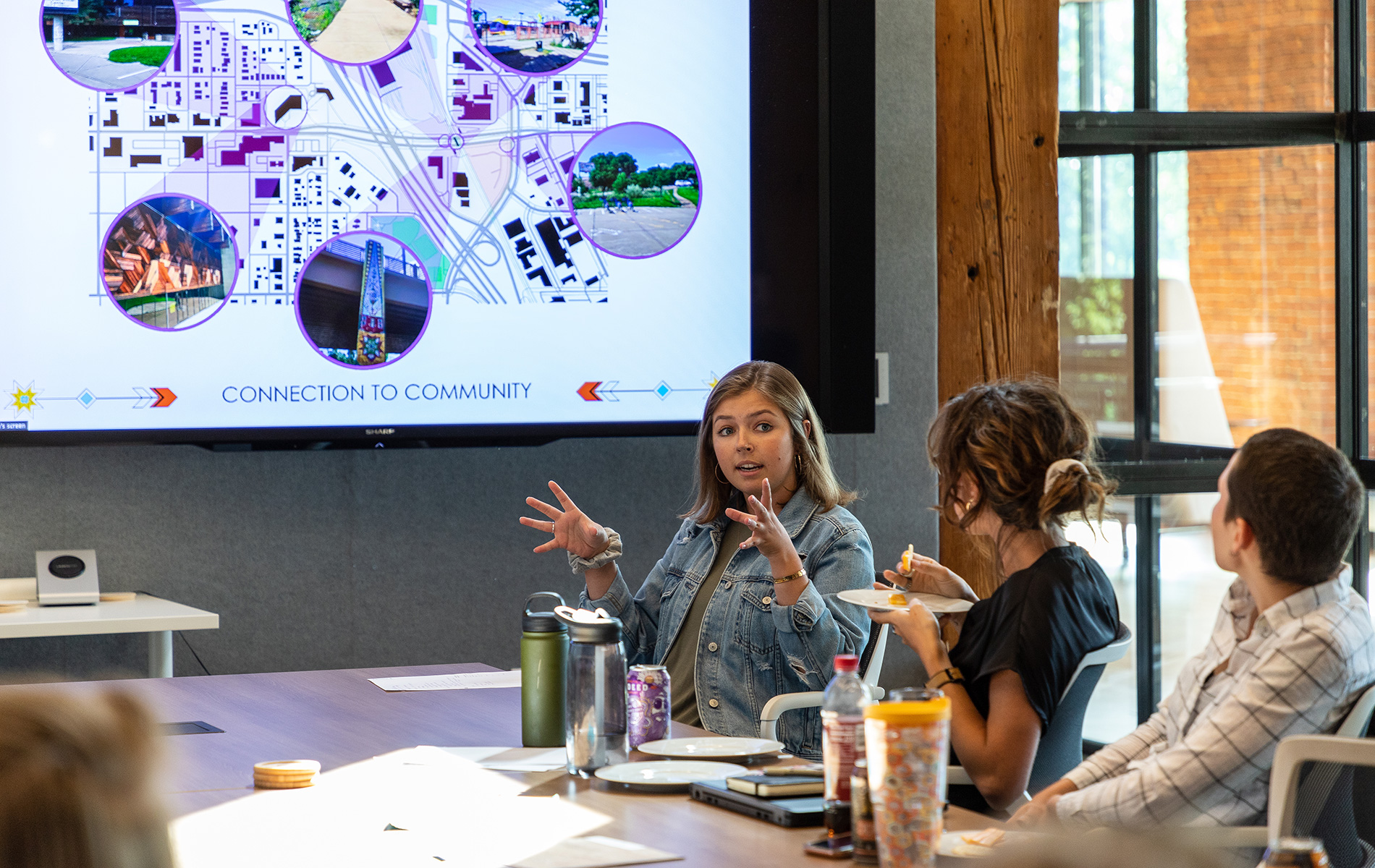Summer Interns Explore American Indian Cultural Corridor with Collaborative Project
Summer Interns Explore American Indian Cultural Corridor with Collaborative Project

How does one attract, approach and enter a space?
This is the question that the 2019 Summer Student Intern Cohort was tasked with investigating as part of their collaborative project, a staple of Cuningham Group's Summer Student Cohort program.
Working collaboratively across all six of Cuningham Group’s U.S. offices, this year’s cohort explored the American Indian Cultural Corridor (AICC), developing design proposals for an existing site featuring a cultural education center. Split into four teams, each group worked together to develop their own unique, culturally-sensitive design solution. Limited only by the site’s parameters and their imaginations, the groups conducted site visits and extensive external research to guide their design processes. The interns presented their final design solutions to the firm last Thursday.
[gallery ids="23278,23282,23276"]
The first group, comprised of Dana Saari, Zihao Yang, Taylor Abbott, and Shannon McElroy, designed a program that accentuates the existing education center by both honoring the past and investing in the future. Included in their proposal was the transformation of an underutilized median into a walkway that details Native American history and a space that symbolically uses water, art, and weaving to energize the community and provide opportunities for refuge and rebirth.
[gallery type="slideshow" columns="1" size="full" mkslideshow="true" ids="23413,23325,23326,23327,23328,23329,23330,23331,23332"]
During their initial site visit, members of the second group — Hannah Koch, Keira Rachac, Jesse Terzic, and Kay Walker — noticed the AICC’s strong connections to nature and local cultural traditions. Their design emphasized these connections, using biophilic elements to merge the indoors and the outdoors. Other design features included a symbolically-significant building footprint, stark geometry throughout, and a large skylight that floods the entrance with daylight, drawing users inward.
[gallery type="slideshow" mkslideshow="true" size="full" ids="23414,23343,23344,23346,23345,23347,23348,23349,23352,23351,23350"]
The third group, which included Samia Mansour, Haley Strowbridge, Angel Soto, and Kyndra Trevino-Scott, focused on education through the lens of mental health, designing a space that embraces the existing landscape, resulting in a safe and welcoming environment. The group used the Native symbolism of the four cardinal directions as a way to orient the building’s footprint and guide its programmatic elements. Also included was a focus on sustainability and locally-sourced building materials.
[gallery type="slideshow" mkslideshow="true" size="full" ids="23415,23406,23356,23357,23358,23359,23360,23361,23407"]
The final group, consisting of Alison Mercado, Rachel Peterson, Mohammadmehdi Danesh, and Jane Jackson, found design inspiration in the way Native Americans traditionally viewed the land and sky. From this, they developed a concept that utilizes culturally significant art and an integrated landscape design to mitigate the corridor’s poor connection with the metro and surrounding urban areas. The building’s footprint, a semi-circle that “hugs” the site, folds over itself, creating an inviting and playful relationship to the rest of the corridor.
[gallery type="slideshow" mkslideshow="true" size="full" ids="23416,23393,23394,23395,23396,23397,23398,23399,23400,23401,23402,23404,23403,23392"]
“There was consistent, thoughtful design throughout all the presentations,” Principal Paolo Lovagnini said. “These are lessons that we can all learn from and integrate into our own practices.”
Cuningham Group Principal and Full Circle Indigenous Planning Founding Principal and CEO Sam Olbekson had similarly kind words to say about the interns’ designs.
“I liked the research [they] put in,” Olbekson said. “It’s important to study people and culture, no matter the client. I also appreciated the experimentation and thoughtfulness, and socio-political elements.”
For many of the interns, this was their first time working across the country on a project. As such, they had to put their communication and collaboration skills to the test, working through different time zones, cultural differences, and creative approaches.
“I liked getting to know the other interns and seeing new ways to work,” Landscape intern Rachel Peterson said. “It was inspiring and gave me insight on new ways to design in the future.”
Architecture intern Samia Mansour echoed Peterson’s sentiment, adding that she was inspired by both the focus of the project, as well as her colleagues’ work.
“The collaborative project was a great way to show how impactful architecture can be and how what we're designing is much more than just a building,” Mansour said. “It was an awesome experience to get to work with fellow interns in other offices and see how each of our specific talents can come together to make something great.
[gallery size="full" mkslideshow="true" type="slideshow" ids="23334,23338,23339,23337"]